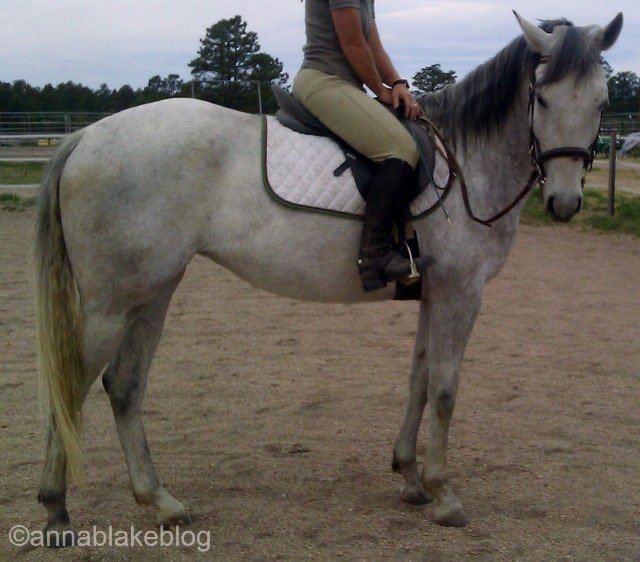 Most of us started as back yard riders. No shame, we were kids, we climbed up and rode. When we fell off, we climbed up and rode some more. I must have known there was tack, I watched westerns on TV after all, but we didn’t own any. We thought you kicked a horse to make him trot and if you wanted to canter, you kicked even harder, and maybe flung yourself forward while pulling up on his face. No, not pretty but we all had to start somewhere and our horses taught us to ride better. Some of us took the cue with more grace than others -and when we knew better, we did better. Some of us were more defensive and adversarial; we enjoyed the drama and adrenaline of a fight. Do you know someone like that? The other word for it is Bully.
Most of us started as back yard riders. No shame, we were kids, we climbed up and rode. When we fell off, we climbed up and rode some more. I must have known there was tack, I watched westerns on TV after all, but we didn’t own any. We thought you kicked a horse to make him trot and if you wanted to canter, you kicked even harder, and maybe flung yourself forward while pulling up on his face. No, not pretty but we all had to start somewhere and our horses taught us to ride better. Some of us took the cue with more grace than others -and when we knew better, we did better. Some of us were more defensive and adversarial; we enjoyed the drama and adrenaline of a fight. Do you know someone like that? The other word for it is Bully.
Learning is a vulnerable position. It involves listening with an open mind and a willingness to consider the big picture. Learning is a desire to look past the surface of how things work to the inner-relationship of the parts, to reason and creatively participate. Learning while sitting on top of a thousand pound horse, who has thoughts and emotions of his own, complicates things.
It’s easy to have sensory overwhelm in the saddle, and tell our brains to shut down the information intake. In riding, an over-controlling or closed mind is the enemy of sensitivity. It takes us out of the conversation with the horse in the moment and into a conversation with our own brains about the horse. It’s a huge difference; it’s going from talking to them to talking about them. We want to balance on the tight wire between sensing physically and thinking emotionally. It’s the difference between responding and reacting; one is inclusive and one is defensive. Did I mention that this is only a tight wire wide?
Here is where I remind you riding is an art. It’s supposed to be challenging.
At the same time, some of us think that leadership is about domination. I understand the attraction to this sort of training. It’s black and white. The rider has control by using dominance to correct what is already in the past.
Example: The horse is tossing his head, so she pulls on his face. He pulls more, so she bumps with the bit. He flinches, his poll gets tense, and he pushes for some relief. Metal on bone, she corrects his face with aggressive hands. Each toss gets more tense, each correction more punishing. She’s stopped listening to her horse, now he’s getting a lesson in fight and resistance. And us humans have an innate urge to dominate, maybe even more so when we’re intimidated. It feels like a natural response. How is this working?
In training there is a movement to change the word submission to coöperation. Great idea!
“You don’t make him learn, you set it up to allow him to learn. You have to give him that with dignity. Once you start giving, you won’t believe how much you get back.” Ray Hunt, dressage master in different tack.
In the same example, if the rider comes from a standpoint of learning, being open with her senses, the conversation can take place in the present. Rather than correcting the last mistake, the horse/rider can negotiate. If the horse tugs, you might be reminded that your hand has become set, you can take the cue to follow his movement better, encouraging the horse to move forward more. It stops being black or white, right or wrong, good or bad. Instead the lines become more flexible, senses more aware and both minds are open communicating. This is the exact spot that brilliance is possible. Art can happen. In this place, vulnerability is our greatest strength; a positive willingness to let the horse to do what we ask.
Again, most of us started in our backyards. We didn’t know how much we didn’t know. We just wanted to ride. If we kept at it, we looked for markers of our skill. Here’s my rule of thumb: A rider who thinks they are right is a rank beginner. A master in the saddle is one who is vulnerable to learning:
It was noted that Nuno Oliveira, the Portuguese Master, rode very hunched over during the last years of his life and yet he became a better rider, his horses were also more relaxed and brilliant. He remarked that it was a pity that his back was giving up “because it is now that I am beginning to learn how to ride a horse.”
Anna Blake, Infinity Farm.
You need to be a member of Barnmice Equestrian Social Community to add comments!
Join Barnmice Equestrian Social Community